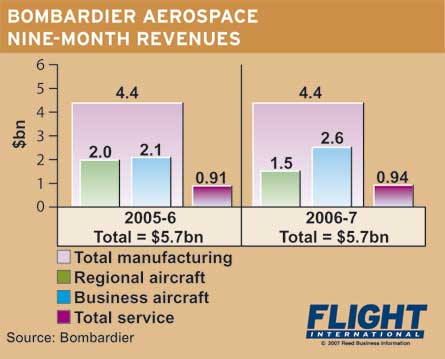Having a presence in both business and regional aircraft has helped Bombardier Aerospace ride out rough times in both markets. When the US corporate aviation sector collapsed after 9/11, regional jets helped keep the cash flowing. Today, with regional aircraft output slowing to just 112 aircraft in 2006, it is the booming business aviation sector fuelling revenues.
The Canadian company's product line is more diversified than any airframer, spanning 37-seat turboprops to top-end business jets. With its origins in a flurry of acquisitions from the mid-1980s its breadth is arguably its biggest strength. The fuel price has prompted cost-conscious regional airlines to turn to the Q400 80-seat turboprop, derided as a dinosaur when it entered service at the turn of the century. The business jet range, from the Learjet family of light and mid-size aircraft to the ultra-long-range Global Express, coupled with a global sales and support network and charter arm, has helped it tap into the fast-growing markets of Asia, the Middle East and Russia.
But now, as parent Bombardier prepares to announce its results for the year to 31 January later this month, all eyes are on the airframer's next move following a spell of fairly flat financials.

After a spate of launches in the late 1990s and early 2000s - including the Challenger 300, Global Express and Q400 - Bombardier is under pressure to revitalise its offering with a new generation of products. Opportunities include a faster or longer-range premium business jet - it competes in the long-range sector with Dassault and Gulfstream, but also with Airbus's ACJ and Boeing's BBJ. Another possibility is an entry-level business jet. Unlike rivals Cessna and Embraer it has nothing in the market's fastest-growing segment, very light jets (it has been linked with German specialist airframer Grob, maker of the all-composite SPn business jet). But most crucial is the question of whether Bombardier will enter the mainline airliner segment with the long talked-about CSeries.
Developing the latter - Bombardier has a team of 50 keeping the project alive after shelving its launch last year - will cost $2 billion, and some are far from convinced. Teal Group's Richard Aboulafia insists the aircraft will fail to see the light of day. "I'm not looking for anything more than continued deferrals or a cancellation in the year ahead," he says.

However, speaking to Flight International last week, Bombardier Aerospace president and chief operating officer Pierre Beaudoin insisted a formal launch is still possible. "We are very confident about the technology we now have compared with the product we had last year," he says.
Like its counterparts, Bombardier is wrestling with the thorny question of outsourcing. Last year, it opened a factory in Mexico, but announced job cuts elsewhere, including at the former Shorts plant in Belfast, UK. Beaudoin says Bombardier was a pioneer in sharing the cost and risk of a programme with global partners on the Challenger 300 in the late 1990s. The vertically integrated manufacturing concept of "metal in one end and an aircraft out the other" is "something we decided 10 years ago was not the way", he says.
Bombardier still has scope to keep customers happy with new versions of existing products. Last month, it launched the CRJ1000, a 100-seat stretch of its CRJ900. Although not a game-changer (Bombardier has 38 launch orders, 15 of which have switched from the CRJ900), the aircraft allows it to compete with Embraer's largest regional jets and is a relatively risk-free move. Bombardier may do similar in the turboprop market with a Q400 stretch - something Beaudoin confirms is under consideration but "won't happen tomorrow".
Some may suggest the CRJ1000 is Bombardier's way of keeping at least some of the demand for the CSeries at bay, although Beaudoin says the two products are intended for different markets, with very little overlap.
But with demand booming in business aircraft and the sluggish regional market expected to bounce back in the 70- to 100-seat market, the sceptical view is that pouring resources into an all-new aircraft that will compete with Airbus and Boeing is the last thing Bombardier needs. Aboulafia again: "Bombardier has an enviable position in the business-jet segment, where they tie for number one position in a strong growth market," he says. "Yet they've fallen behind their rivals for new product launches, probably because of the poorly thought-out CSeries diversion. They need to resume spending on business jets, where they'll find much more growth and profit than regional jets."
A full version of the Beaudoin interview will appear in our 3 April Canadian industry special.
Source: Flight International
















